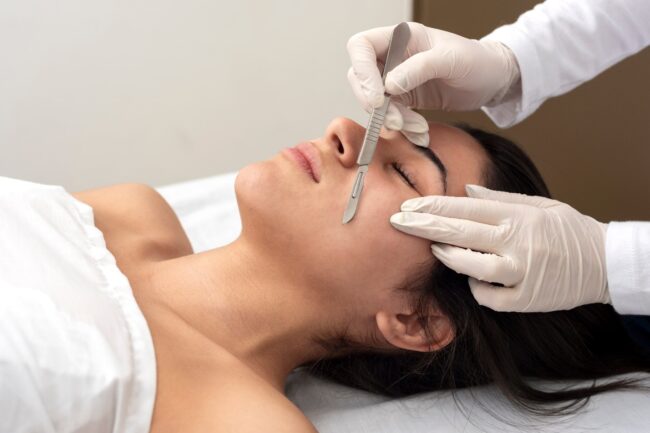Dermaplaning is a popular skincare treatment that has gained significant attention in recent years. This non-invasive procedure offers numerous benefits, such as removing dead skin cells and fine facial hair, resulting in smoother, brighter skin. Dr. Jason Emer reviews what dermaplaning is, how it works, its benefits, potential risks, and what you can expect from the treatment.
What is Dermaplaning?
Dermaplaning is a cosmetic procedure that involves gently scraping the surface of the skin with a sterile surgical scalpel to remove dead skin cells and peach fuzz (vellus hair). This technique exfoliates the skin, leaving it feeling smooth and looking more radiant. Unlike other exfoliation methods, such as chemical peels or microdermabrasion, dermaplaning is a manual exfoliation technique that requires no downtime, making it a popular choice for those seeking a quick and effective treatment.
How Does Dermaplaning Work?
During a dermaplaning session, a licensed esthetician or dermatologist uses a small, sterile blade to exfoliate the skin’s surface gently. The professional holds the skin taut and makes short, swift strokes with the blade at a 45-degree angle. This process removes the outermost layer of dead skin cells, dirt, oil, and fine facial hair, which can clog pores and cause a dull complexion.
The procedure usually takes about 30 minutes and is often performed as part of a facial treatment. Because dermaplaning is non-invasive and does not involve any chemicals, it is suitable for most skin types, including sensitive skin.
Benefits of Dermaplaning
- Instantly Smoother Skin: One of the most noticeable benefits of dermaplaning is the immediate smoothness it provides. By removing the outer layer of dead skin cells and fine hair, the skin feels softer to the touch.
- Improved Skin Texture and Tone: Regular dermaplaning can help improve the texture and tone of the skin by removing dead cells and promoting new cell turnover. This can result in a more even complexion and reduced appearance of hyperpigmentation and acne scars.
- Enhanced Product Absorption: After dermaplaning, skincare products can penetrate the skin more effectively, making them more beneficial. This is because the removal of dead skin cells allows serums, moisturizers, and other treatments to absorb deeper into the skin.
- Makeup Application: With the removal of peach fuzz and dead skin, makeup can be applied more smoothly and evenly. Foundation and powder are less likely to settle into fine lines and wrinkles, allowing for a flawless finish.
- Non-Invasive and Pain-Free: Dermaplaning is a non-invasive procedure that is generally pain-free. Most people describe the sensation as a gentle scraping feeling, which is not uncomfortable.
Who Should Consider Dermaplaning?
Dermaplaning is suitable for most skin types, particularly those looking for a quick, non-invasive treatment to enhance their skin’s appearance. It is especially beneficial for individuals with:
- Dull or dry skin: Dermaplaning can help remove the buildup of dead skin cells that can cause a lackluster complexion.
- Fine lines and wrinkles: The exfoliation process can smooth out the skin’s surface, reducing the appearance of fine lines and wrinkles.
- Acne scars or uneven skin tone: Dermaplaning can help improve the skin’s texture and promote a more even tone.
- Excessive facial hair (peach fuzz): For those bothered by fine facial hair, dermaplaning is an effective way to remove it temporarily.
However, dermaplaning may not be suitable for individuals with active acne, rosacea, or other skin conditions that cause inflammation or open wounds. It’s essential to consult with a dermatologist or skincare professional before undergoing the procedure to ensure it’s the right treatment for your skin type and concerns.
What to Expect During and After the Procedure
During the Procedure:
The dermaplaning process is straightforward and usually performed in a skincare clinic or dermatologist’s office. The esthetician or dermatologist will begin by cleansing the skin to remove any makeup, dirt, or oil. They may then apply a solution to help soften the skin and make the exfoliation process more effective. The actual dermaplaning process involves gently scraping the skin with a sterile blade in controlled, short strokes.
After the Procedure:
Post-treatment, the skin may appear slightly pink or flushed, which is normal and should subside within a few hours. Some people experience a mild tingling sensation, similar to a mild sunburn, but this typically resolves quickly. It is crucial to apply sunscreen and avoid direct sun exposure for a few days following the procedure, as the newly exfoliated skin can be more sensitive to UV rays.
Skincare professionals often recommend applying a soothing moisturizer or serum immediately after dermaplaning to hydrate and protect the skin. Most people notice immediate results, such as a smoother texture and a brighter complexion. For optimal results, dermaplaning can be performed every 3 to 4 weeks, depending on individual skin type and concerns.
Potential Risks and Side Effects
While dermaplaning is considered a safe procedure with minimal risks, it is not entirely without potential side effects. Some individuals may experience slight redness, irritation, or dryness after the treatment. In rare cases, dermaplaning can cause small cuts or nicks on the skin, which should heal quickly if properly cared for.
It is essential to choose a licensed and experienced professional to perform dermaplaning, as improper technique may increase the risk of adverse effects. Additionally, those with a history of keloid scars or other skin conditions should consult with a dermatologist before undergoing the treatment.
Dermaplaning is an effective and popular skincare treatment that can provide instant results, such as smoother, brighter skin and enhanced product absorption. It is suitable for most skin types and offers a non-invasive, pain-free way to improve skin texture and tone. However, as with any cosmetic procedure, it is crucial to consult with a qualified professional to determine if dermaplaning is the right choice for you. By understanding the benefits, risks, and what to expect, you can make a well-informed decision about whether dermaplaning is the best option for achieving your skincare goals.
